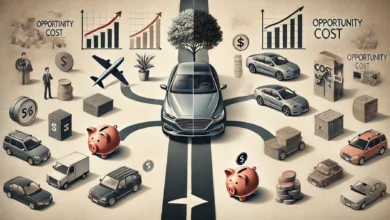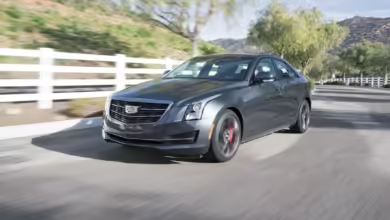
As the automotive industry pivots towards sustainability, electric vans are becoming a cornerstone for businesses and families alike seeking eco-friendly transportation solutions. In 2024, a new lineup of electric vans promises enhanced performance, improved range, and innovative technology, catering to diverse needs and preferences. This review explores the best new electric vans hitting the market, offering a comprehensive guide to their features, benefits, and how they stack up against their fossil-fueled counterparts. Whether you’re looking for cargo space, efficiency, or tech integrations, the evolving market of electric vans has something to offer.
Check Also: Best cars for delivery drivers 2024
#1 Volkswagen ID. Buzz Cargo

The Volkswagen ID.Buzz Cargo not only revives the nostalgic aesthetics of the iconic Type 2 but also introduces a modern twist with its impressive electric capabilities, making it our 2023 Electric Van of the Year. Here’s why this electric van is turning heads and redefining the standards for commercial electric vehicles.
Design and Platform
The ID.Buzz Cargo’s design is a clever homage to the past, fused with the cutting-edge technology of today. Riding on Volkswagen’s MEB platform, which it shares with siblings like the ID.3, ID.4, and ID.5, the ID.Buzz Cargo offers a driving experience that’s remarkably car-like. This is a significant advantage in a segment where commercial vehicles often sacrifice driveability for utility.
Performance and Efficiency
Under the rear hood, the ID.Buzz Cargo is equipped with a 201bhp electric motor that delivers brisk acceleration, capable of reaching 0-62 mph in just 10.2 seconds. This power, combined with the instant torque characteristic of electric motors, makes the ID.Buzz ideal for quick urban deliveries and agile enough for tight city maneuvers.
The electric prowess extends to its range and recharging capabilities. With a 77kWh battery providing up to 256 miles on the WLTP combined cycle, the ID.Buzz Cargo leads its class in range efficiency. Moreover, the fast-charging capability allows the battery to rejuvenate from 5% to 80% in under 30 minutes, a feature that minimizes downtime and maximizes productivity for commercial users.
Capacity and Interior
Despite its compact exterior dimensions, which make it shorter than a Tesla Model Y, the ID.Buzz Cargo does not skimp on space. Offering 3.9 cubic metres of cargo volume, it surpasses many competitors, including the Volkswagen Caddy Cargo. This spacious interior is engineered to maximize every inch, providing a practical and versatile space suited for a variety of business needs.
Ride Comfort and Handling
The vehicle’s architecture also excels in comfort, with a suspension system adept at absorbing road imperfections, ensuring a smooth ride even when fully loaded. This is particularly beneficial for maintaining the integrity of cargo over long distances or rough urban environments.
#2 Ford E-Transit
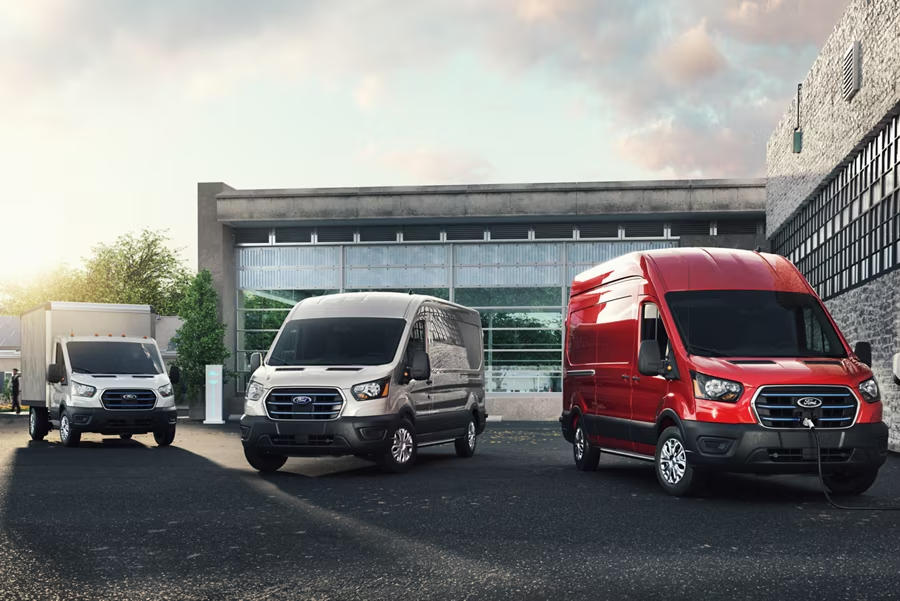
Last year’s accolade as Electric Van of the Year was no fluke for the Ford E-Transit. This year, it continues to impress, solidifying its reputation as one of the most robust and capable electric vans available today. Let’s explore the features that keep the E-Transit at the top of its game.
Performance and Versatility
The Ford E-Transit offers an impressive electric range of up to 196 miles, making it a viable competitor in the electric commercial vehicle market. For those needing a bit more pep, the optional 265bhp motor transforms the E-Transit into a surprisingly agile performer, quick off the line and more than capable of handling hefty payloads without a hitch.
Ford’s diverse lineup includes several variants of the E-Transit to suit various business needs, from a spacious panel
Design and Capacity
One of the E-Transit’s most notable features is its retention of cargo space from its diesel counterpart, offering up to 15.1 cubic metres. This makes it an easy switch for businesses looking to transition from diesel without compromising on space or utility. The choice of heights (H2, H3) and lengths (L2, L3, and L4) further enhances its appeal, allowing for a tailored fit for any commercial requirement.
Charging and Battery Life
All variants of the E-Transit are equipped with a 68kWh battery, which supports a range of up to 198 miles depending on the configuration and driving conditions. The ability to rapid-charge from 15% to 80% in just 34 minutes with a 115kW charger means minimal downtime and more time on the road, a crucial factor for maximizing operational efficiency in commercial use.
Interior and Technology
Inside, the E-Transit does not disappoint. The cabin offers a commanding driving position, large mirrors for better visibility, and ample storage solutions, creating a workspace that is both functional and comfortable. Optional features like Ford’s SYNC4 12-inch touchscreen, adaptive cruise control, climate control, and an array of electronic driver aids elevate the driving experience, merging convenience with safety.
#3 Renault Kangoo E-Tech – A Top Contender Among Electric Cargo Vans 2024
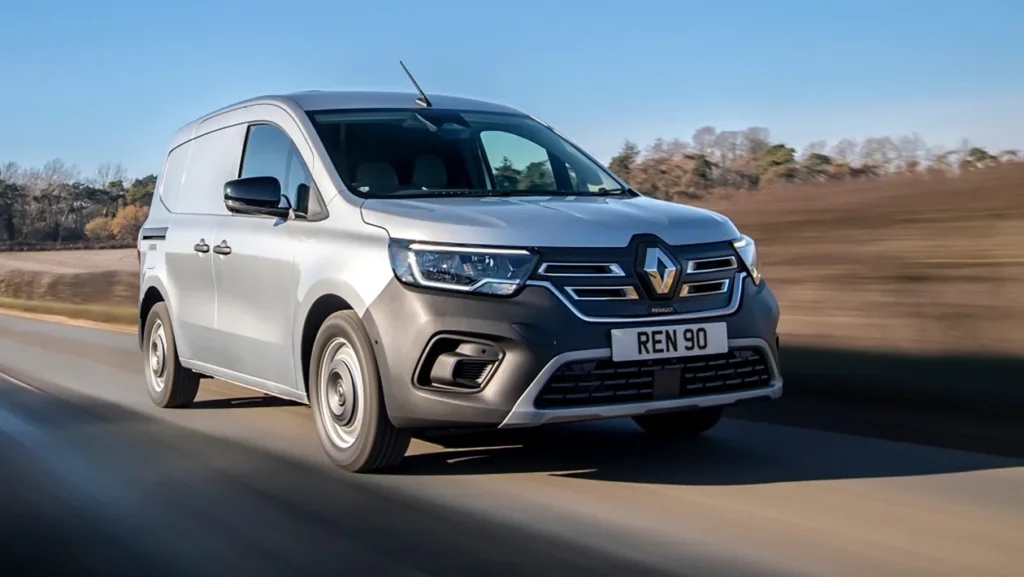
The electric vehicle market continues to expand rapidly, with electric cargo vans leading the charge into a more sustainable future. As we approach 2024, the Renault Kangoo E-Tech Electric emerges as a strong contender in this competitive field. Building on the legacy of the pioneering Kangoo Z.E., the latest model is designed to meet the demands of modern transportation with enhanced efficiency and style. Here’s why the Kangoo E-Tech is setting standards for electric cargo vans in 2024.
Upgraded Performance and Range
Renault has significantly upgraded the Kangoo E-Tech with a larger 44kWh battery paired with a 118bhp front-mounted electric motor. While it’s not the fastest van on the block, this setup provides a substantial electric range of up to 186 miles, making it highly suitable for urban deliveries and small businesses looking for cost-effective solutions without the range anxiety.
Sophisticated Design and Utility
Reflecting a more modern aesthetic, the Kangoo E-Tech features sharper exterior styling, moving away from its utilitarian roots to a more sophisticated and appealing design. This approach not only enhances its street presence but also aligns with contemporary consumer expectations for vehicles that are both functional and stylish.
Interior and Technology
Inside, the Kangoo E-Tech borrows elements from Renault’s Clio supermini, including switchgear and the steering wheel, elevating the cabin’s feel to a more upmarket level. Standard models come equipped with a basic 3.5-inch media system, while higher-spec versions boast an 8.5-inch touchscreen complete with Apple CarPlay and Android Auto connectivity. This blend of car-like comfort and technology in a commercial vehicle enhances its appeal, especially for those who spend many hours on the road.
Versatility and Capacity
The Kangoo E-Tech is offered in both standard and long-wheelbase versions. The standard model provides 3.3 cubic metres of cargo space, while the long-wheelbase version increases this to 4.2 cubic metres, making it a flexible option for varied business needs. However, the addition of the battery pack necessitates a reduction in payload capacity to accommodate the extra weight, with the standard van carrying up to 608kg, and the LWB model capable of up to 764kg.
#4 Fiat E-Ducato

Fiat’s E-Ducato stands out in the emerging market of new EV vans for 2024, showcasing extensive versatility and tailored solutions for a range of business needs. With its vast array of body styles, powerful battery options, and substantial cargo capabilities, the E-Ducato is meticulously designed to meet the evolving demands of modern enterprises and eco-conscious entrepreneurs. Let’s delve into the features and functionalities that position the E-Ducato as a frontrunner among new EV vans in 2024.
Customization and Versatility
The E-Ducato offers unprecedented customization for an electric van, featuring three different lengths and heights in the panel van configuration, culminating in a total of 28 possible body styles. This level of variety is practically unmatched in the sector, allowing businesses to select the perfect model for their specific operational requirements, whether that involves bulky item deliveries or compact urban transport solutions. For those needing specialized configurations, Fiat also offers a chassis cab option and a passenger version that can comfortably seat up to nine individuals, broadening its application to include commercial passenger services.
Capacity and Payload
With cargo volumes ranging from 10 to 17 cubic metres, the E-Ducato is well-equipped to handle large loads, making it a practical choice for businesses looking to maximize efficiency on each trip. The van is also capable of handling significant weight, supporting gross vehicle weights of up to 4.25 tonnes, with the potential for payloads up to 1.9 tonnes. This capability ensures that the E-Ducato can perform under various loads without compromising performance, making it a robust option for heavy-duty use.
Battery Options and Charging Efficiency
The E-Ducato comes with two battery choices: a 47kWh pack offering a range of 146 miles and a larger 79kWh pack that can achieve up to 230 miles. This flexibility allows businesses to select the battery that best fits their daily mileage needs, balancing cost and capability effectively. Fiat has also enhanced the charging technology in the E-Ducato, with a maximum recharge rate of 50kW. This setup allows the smaller battery to reach 80% charge in just 50 minutes, while the larger battery takes approximately 85 minutes to charge to the same level, ensuring that the vehicle spends more time on the road and less time at charging stations.
#5 LEVC VN5 – A Smart Hybrid Choice Among EV Cargo Vans

2024 LEVC VN5 emerges as a noteworthy contender with its hybrid approach that sets it apart from conventional electric-only models. The VN5’s design cleverly leverages technology honed in LEVC’s famed taxi lineup, providing a versatile and efficient solution for urban and extended range applications. Here’s why the VN5 should be a top consideration for those in the market for a n
Innovative Hybrid Technology
The VN5 utilizes a plug-in hybrid system that includes a 31kWh battery powering an electric motor, with a petrol engine that acts exclusively as a generator. This arrangement allows the VN5 to offer an impressive all-electric range of 73 miles. When the battery’s charge is depleted, the petrol engine kicks in to extend the total driving range to 309 miles. This dual-function capability ensures that the VN5 can operate with the efficiency of an electric vehicle for daily urban deliveries while also providing the long-range versatility of a petrol engine, making it ideal for longer trips where charging stations might be sparse.
Cargo and Capacity
While not the largest in its class, the VN5 still offer
Interior and Features
Inside, the VN5 is equipped with features that enhance both comfort and functionality. Standard offerings include dual-zone climate control, Bluetooth connectivity, two USB ports, a nine-inch touchscreen, keyless start, and automatic LED headlights. These features ensure a comfortable and convenient environment for drivers who spend many hours on the road.
Warranty and Incentives
LEVC supports the VN5 with a competitive warranty package, including a five-year/150,000-mile vehicle warranty and an eight-year battery warranty. Additionally, the VN5 qualifies for the government’s £5,000 plug-in van grant, which enhances its appeal as a cost-effective solution for businesses looking to reduce both emissions and operational expenses.
#6 Mercedes eSprinter/eVito
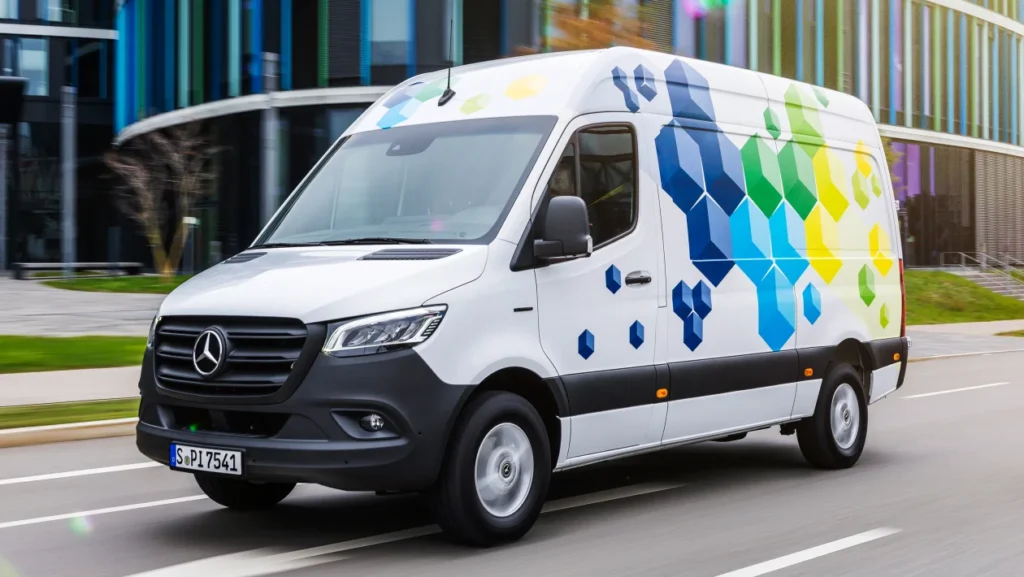
Mercedes-Benz continues to be at the forefront of electric vehicle innovation, especially with its compelling lineup of EV cargo vans. The eSprinter and eVito models represent Mercedes’ commitment to blending traditional utility with modern, eco-friendly technology. Here’s a closer look at these two key players in the EV cargo van segment as we move into 2024.
Mercedes eSprinter: Spacious and Efficient
The eSprinter, the larger of the two, offers a substantial cargo volume of up to 11 cubic metres, providing ample space for various commercial uses. Originally equipped with a 55kWh battery offering up to 83 miles of range, the eSprinter saw a significant update in 2023. The introduction of a new 113kWh battery extended its range to an impressive maximum of 248 miles, making it one of the most capable electric vans in terms of distance per charge.
Recharging the eSprinter has also become more efficient. With the ability to handle up to 115kW of charging power, the van’s battery can be recharged from 10% to 80% in just 42 minutes. Additionally, for more regular charging needs, there’s the option to use an 11kW wallbox charger.
Mercedes eVito: Compact and Reliable
The eVito, known for being Mercedes’ first all-electric van, offers a more compact solution with up to 6.6 cubic metres of cargo space. It’s ideal for businesses that operate primarily in urban settings where shorter trips and tighter spaces are common. The eVito started with a 41kWh battery that provided up to 92 miles of range. In 2022, a 66kWh battery option was added, extending the range to approximately 162 miles.
Unlike the eSprinter, the eVito does not support fast-charging, which may be a consideration for those needing quicker turnaround times. However, it still maintains the practicality of the standard Vito but with zero emissions. Charging the eVito is straightforward, utilizing a socket located where the diesel fuel filler used to be, with a full recharge possible in six hours at 7.2kW.
Body Options and Practicality
Both vans maintain the body length options and cargo volumes of their diesel counterparts, ensuring that businesses do not have to compromise on space when choosing an electric model. This seamless transition from diesel to electric helps companies maintain operational efficiency while moving towards sustainability.
#7 Peugeot e-Partner
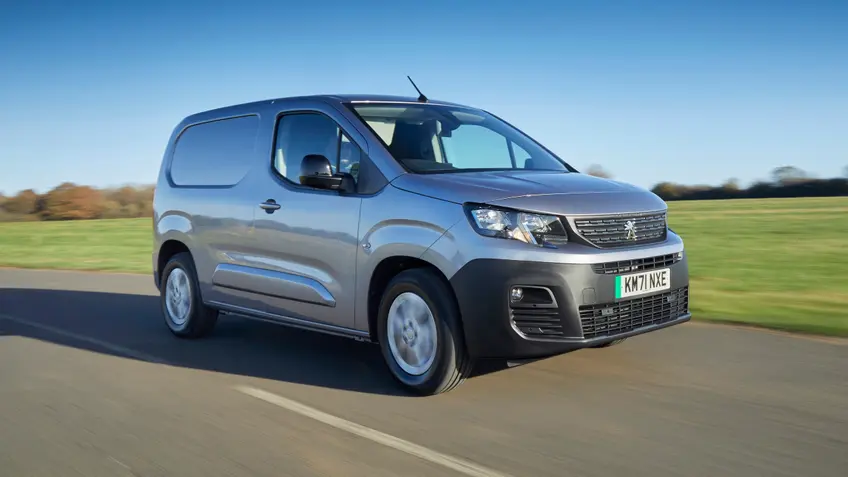
When it comes to choosing a small electric van, the market is brimming with options that cater to a variety of business needs. Among these, several models from the Stellantis group, including the Citroen e-Berlingo, Fiat e-Doblo, Peugeot e-Partner, Toyota Proace City Electric, and Vauxhall Combo Electric, share a lot of common features. All are built on the versatile EMP2 platform, equipped with a 50kWh battery, and boast an identical claimed range of 171 miles. Despite these similarities, each model brings its own unique flair to the segment.
Choosing the Peugeot e-Partner
Our spotlight falls on the Peugeot e-Partner, primarily for its distinctive iCockpit found in Peugeot’s passenger car lineup. This innovative design feature includes a compact steering wheel paired with a high-mounted instrument cluster, creating an engaging and ergonomically enhanced driving experience. This layout is not just about aesthetics—it’s designed to enhance driver comfort and vehicle control, making the e-Partner a standout choice for those who spend many hours on the road.
Style Meets Function
The iCockpit arrangement is somewhat polarizing; drivers tend to either love it or loathe it. However, it undeniably adds a level of style and modernity that its siblings in the Stellantis family don’t quite match. In a market where small electric vans can often appear utilitarian and bland, the e-Partner’s approach proves that commercial vehicles can indeed be both functional and stylish.
Why Van Aesthetics Matter
The importance of vehicle aesthetics extends beyond mere appearance. A well-designed cabin can significantly enhance driver satisfaction, which is crucial for professionals who spend most of their working hours behind the wheel. The ergonomic benefits of the e-Partner’s iCockpit can lead to reduced fatigue and increased productivity, benefits that any business would welcome.
Moreover, in a crowded market, the distinctiveness of a vehicle can be a crucial differentiator. Businesses that prioritize brand image or wish to stand out might prefer the e-Partner for its bold interior design over the more conventional setups found in its competitors.
#8 Toyota Proace Electric
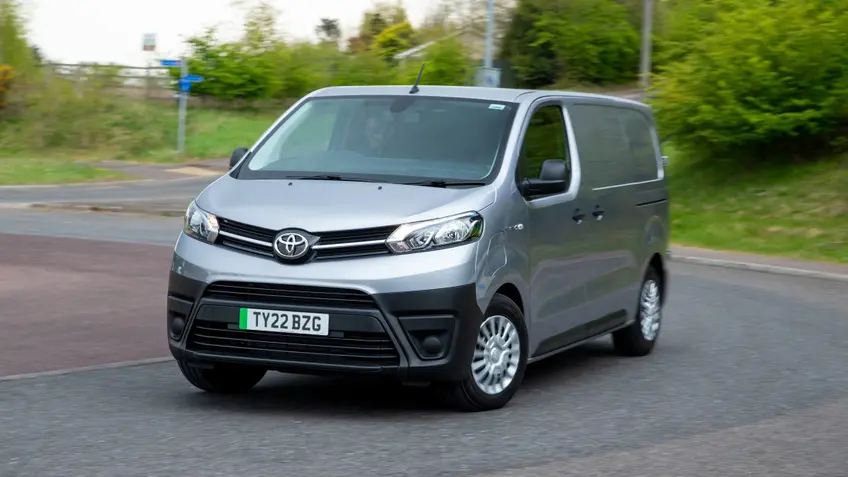
When your business needs expand beyond what small electric vans can handle, stepping up to a mid-sized option offers the perfect blend of usability and efficiency. The Stellantis family, including the Citroen e-Dispatch, Fiat e-Scudo, Peugeot e-Expert, and Vauxhall Vivaro Electric, provides a robust lineup of mid-sized vans built on a shared platform, with the choice between 50 kWh or 75 kWh batteries. These options offer ranges of up to 142 or 205 miles, respectively, catering to varying business needs with their versatile capabilities.
Why Choose the Toyota Proace Electric?
Among its closely related counterparts, the Toyota Proace Electric emerges as a particularly appealing option due to Toyota’s standout approach to warranties—a crucial consideration for any business relying on their vehicles for daily operations.
Extended Warranty Advantages
Every Toyota comes with a three-year manufacturer warranty. Uniquely, Toyota extends this coverage by adding an additional year with every qualifying service, up to 10 years or 100,000 miles. This extended warranty not only enhances the value proposition of the Proace Electric but also provides significant peace of mind for businesse
Platform and Performance
While the Proace Electric shares the same underpinnings and battery options as its Stellantis counterparts, offering similar space and performance metrics, the added warranty benefit is a strong differentiator. Businesses often consider the total cost of ownership when investing in their fleet, and predictable maintenance costs are a significant factor. The extended warranty can be a decisive factor, as it likely means lower expenses and fewer surprises over the van’s operational lifespan.







